
- News
- Basics
- Products
- JP Job shop
- Exhibition
- Interview
- Statistic
- PR
- Download
- Special contents
Basics
April 11, 2022

1. What is an industrial robot?
3. Teaching

Industrial robots are used in a wide variety of fields, such as parts processing plants and electronic circuit board assembly plants.
Key Points of Industrial robots:
・ Arm-type robots work in place of humans at manufacturing sites.
・ Industrial robots are versatile and can be used for various purposes, changing the unit at the end of the arm.
・ Highly safe collaborative robots that can operate together with humans are now available.
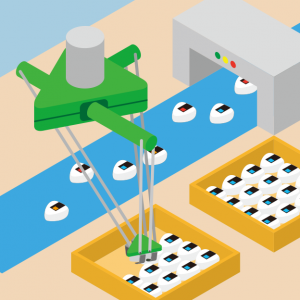 A robot is a machine that performs some tasks in place of a human.
A robot is a machine that performs some tasks in place of a human.
The definition of a robot varies. For example, the Ministry of Economy, Trade and Industry (METI) of Japan defines a robot as “an intelligent mechanical system with three elemental technologies: sensors, controllers and actuators “.
Robots can be broadly classified into industrial robots and service robots. Industrial robots are utilized for industrial purposes and are active in factories, distribution warehouses and other sites.
On the other hand, robots that are not classified as industrial robots, such as cleaning robots or catering robots in restaurants, are called service robots. However, the technical boundary between the two classifications has become blurred over the years.
Although some industrial robots are developed for specific applications, they are basically highly versatile and can be used for a variety of purposes. Industrial robots have a wide range of applications, such as welding, painting, material handling, packaging, and assembly. In particular, industrial robots are used for welding, assembling and material transporting.
The automobile industry and the electrical and electronics industry have introduced many industrial robots. Against the background of a serious labor shortage in advanced countries and growing countries, industrial robots are attracting attention in all industries these days.
There are various types of industrial robots. The four most common types are articulated robot, SCARA robot, delta robot, and cartesian coordinate robot.
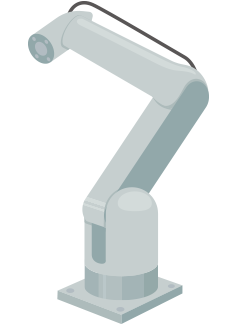
Articulated robots have joints like human shoulders and elbows, and can perform complex movements similar to human arms. Articulated robots are mostly of the 6-axis type, while others have 4, 5 or 7-axes.
This is the type of robot most people first think of when they say “industrial robot”. Articulated robots are implemented for welding and painting, which account for a large percentage of robot applications. They are highly versatile and are used in a variety of sites, such as logistics warehouses and parts processing plants.
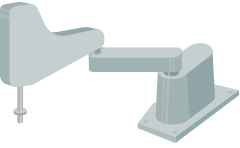 SCARA robots consist of two horizontal rotational axes and one vertical linear axis. Many SCARAs have 4-axes, with horizontal rotation axes at the wrist in addition to these three axes.
SCARA robots consist of two horizontal rotational axes and one vertical linear axis. Many SCARAs have 4-axes, with horizontal rotation axes at the wrist in addition to these three axes.
Unlike articulated robots, which can grasp parts at an angle or from the side, SCARAs can only work from directly above, but they are both horizontally flexible and vertically rigid. This type of robot is therefore suited to assembly tasks such as pushing parts into place, and for transporting small parts.
The name SCARA is an acronym for “Selective Compliance Assembly Robot Arm”.
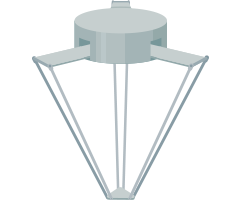 Delta robots (parallel arm robots) are a type of robot in which two sets of three or four pairs of arms support a single tip. A suction unit or other device is attached to the end of the arm to suck and transport the workpiece.
Delta robots (parallel arm robots) are a type of robot in which two sets of three or four pairs of arms support a single tip. A suction unit or other device is attached to the end of the arm to suck and transport the workpiece.
The arms of the delta robots are thin and lightweight, but they are rigid enough to enable very quick movements. This type of robot is mounted on a conveyor belt, for example, to pick up and transport flowing products at high speed.
C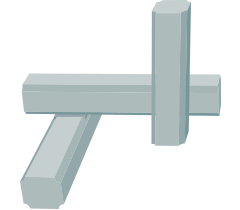 artesian coordinate robots consist of linear axes combined at right angles. This type of robot is used with a single-axis motion unit consisting of a linear guideway and a ball screw. Some products allow the number of axes to be increased depending on the application such as 1-axis (single axis), 2-axis, 3-axis, 4-axis, and 6-axis. Cartesian coordinate robots are the simplest and least expensive, although they are not suitable for complex operations because it consists of only linear axes.
artesian coordinate robots consist of linear axes combined at right angles. This type of robot is used with a single-axis motion unit consisting of a linear guideway and a ball screw. Some products allow the number of axes to be increased depending on the application such as 1-axis (single axis), 2-axis, 3-axis, 4-axis, and 6-axis. Cartesian coordinate robots are the simplest and least expensive, although they are not suitable for complex operations because it consists of only linear axes.
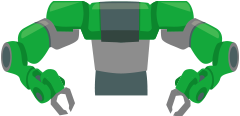 There is also a double-arm robot with two arms attached to a single base. Double-arm robots can perform movements that cannot be done with a single arm, such as holding a box with both hands, and can easily replace human tasks as they are.
There is also a double-arm robot with two arms attached to a single base. Double-arm robots can perform movements that cannot be done with a single arm, such as holding a box with both hands, and can easily replace human tasks as they are.
A new type of industrial robot has emerged that can work in the same space as humans without safety barriers. This is the collaborative robot (Cobot). Users can use cobots without safety fences if they conduct appropriate risk assessments.
In recent years, many of robot manufacturers entered the cobot market. Cobots have high safety features, for example, they are equipped with a function that automatically stops the robot immediately upon contact with a person. Since this type of robot has no safety fence, the footprint of the robot system can be significantly reduced. However, to ensure safety, cobots cannot move very fast.
To operate an industrial robot, the operator first needs to make the industrial robot learn several movements. By connecting these motions, the robot can finally perform the desired operation. The process of making the robot learn the movements is called teaching.
Teaching is done while the operator actually moves the robot using a hand-held control panel called a teach pendant, which is used to operate and program the robot. The robot engineers are required to have considerable know-how for teaching process.
Industrial robots can perform a variety of tasks such as welding, painting, conveyance, and assembly because they can freely change the unit attached to the end of the arm. These units are called “end effectors”.
Grippers are one of the end effectors, used to grab objects. There are two types of grippers: one that opens and closes with the jaws moving in parallel, and the other that opens and closes at a fulcrum by changing the angle of the jaws to grip objects. Grippers are used for a variety of applications, such as transport, assembly, and loading workpieces onto machine tools.
Vacuum grippers are the end effectors consisting of a vacuum generator and suction pads to suck and convey workpieces. They are not suitable for transferring metal parts, but are ideal for loading and unloading cardboard boxes and transporting small, lightweight parts.
There are also various other end effectors such as welding torches, spray guns, and dispensers.

Industrial robots are “semi-finished products” that cannot be used on their own. Industrial robots can only be used on site when they are combined with various peripheral devices and system integration is carried out. The companies responsible for building such robot systems are called system integrators.
In addition to the purchase and production costs of various peripheral equipment, the introduction of a robot system also involves system integration costs. The total cost of a robot system is therefore generally many times higher than the price of the robot itself.
FANUC releases large and small handling robots
Yaskawa Electric launches a cobot with a maximum load capacity of 20 kg
THK launches robo-hand to grip workpieces regardless of shape
DMG MORI develops flexible robot system “MATRIS Light”
February 11, 2022